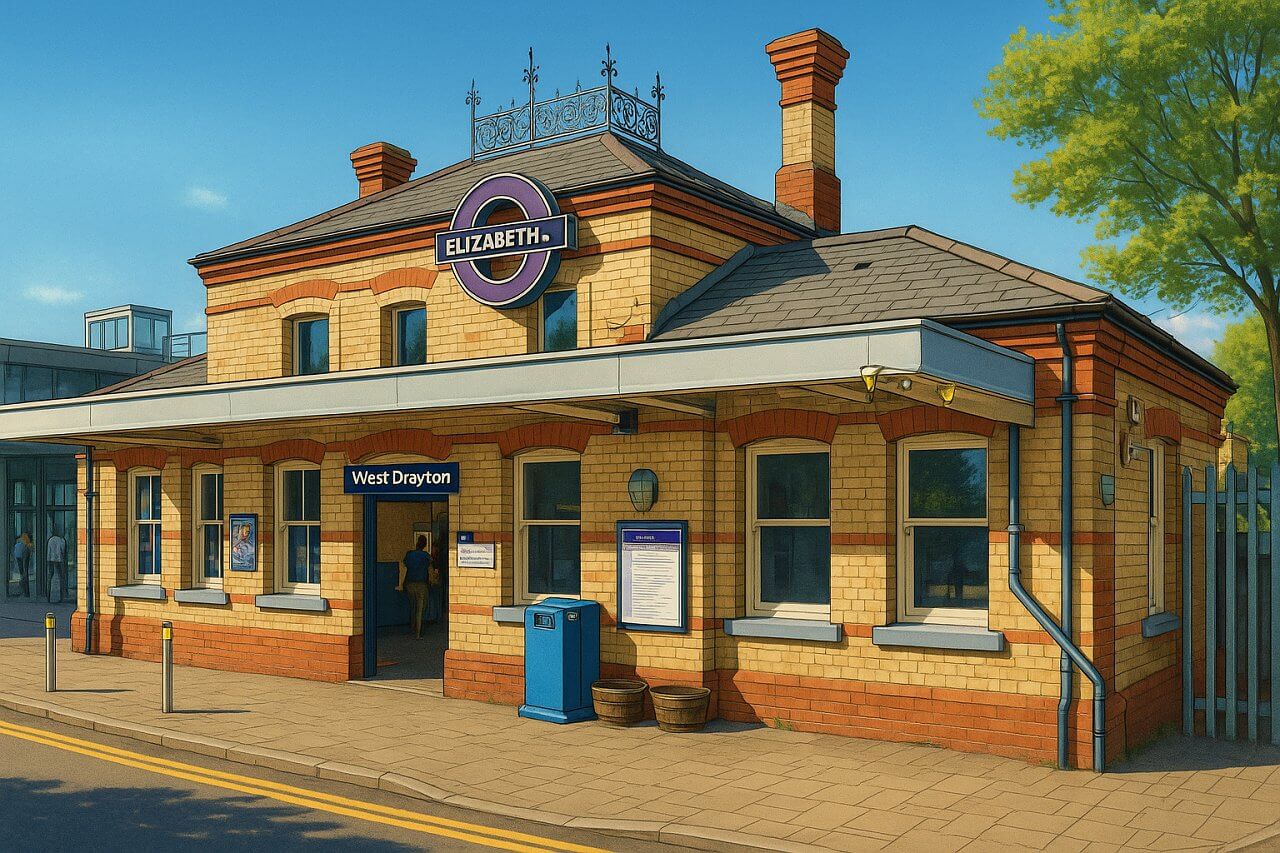
West Drayton Station, London
West Drayton Station is a suburban railway station located in the London Borough of Hillingdon, on the western edge of Greater London. It is served by the Elizabeth Line, offering direct connections to central London, the City, and key destinations such as Reading and Abbey Wood. The station has become an important commuter hub thanks to its fast and frequent services.
Location and Access
West Drayton Station is situated on Station Approach, off Yiewsley High Street and Tavistock Road. The station has a ground-level brick building at its entrance, which houses a small ticket office, ticket machines, and a newsagent kiosk. Step-free access is available to all platforms via lifts and ramps.
History and Origins
The station originally opened on 4 June 1838 as part of the Great Western Railway’s main line from London to Maidenhead. It has retained the name West Drayton since its inception, named after the local village of West Drayton, which dates back to at least the Domesday Book. Over the decades, the station has evolved through several rebuilds and upgrades, most recently in preparation for Crossrail, now known as the Elizabeth Line.
Distance from Charing Cross
By road, West Drayton is approximately 17 miles (27 km) west of Charing Cross, one of the central points of London. Travel time by car typically ranges from 45 minutes to over an hour depending on traffic.
Rail Services and Lines
West Drayton Station is served by:
- Elizabeth Line (TfL Rail) – offering direct services to Reading, Heathrow Airport, Paddington, Liverpool Street, Canary Wharf, and Abbey Wood.
- National Rail (Great Western Railway) – with limited services westbound toward Didcot Parkway and Oxford, and eastbound to London Paddington.
It is not served by the London Underground. For access to London Underground Stations, passengers typically transfer at Paddington or Ealing Broadway for lines including the Bakerloo Line, Circle Line, District Line, Hammersmith & City Line, and Central Line.
Elizabeth Line: Stations and Interchanges
On the Elizabeth Line, the preceding station westbound from West Drayton is Iver, while the subsequent station eastbound is Hayes & Harlington. Trains run frequently in both directions, with peak-time services as often as every 5 minutes.
Fares and Journey Times
To Reading Station
- Single ticket (adult): £11.50
- Oyster/contactless: £8.50 (off-peak), £10.90 (peak)
- Estimated journey time: 38 minutes
To Abbey Wood Station
- Single ticket (adult): £10.90
- Oyster/contactless: £7.20 (off-peak), £9.50 (peak)
- Estimated journey time: 1 hour 6 minutes
To Charing Cross Station
- Single ticket (adult): £9.90
- Oyster/contactless: £6.40 (off-peak), £8.90 (peak)
- Interchange route: Elizabeth Line to Paddington → Bakerloo Line to Embankment → short walk to Charing Cross
- Estimated journey time: 52 minutes
Fun Fact
When the Elizabeth Line launched in 2022, West Drayton Station became one of the line’s most visually transformed stops, thanks to a multi-million-pound redevelopment project that included new lifts, longer platforms, and modernised passenger facilities. Despite its suburban setting, the station now sees over 2.5 million passengers annually1.
Quick Facts
- Station Name: West Drayton
- Located in: London Borough of Hillingdon
- Opened: 4 June 1838
- Lines Served: Elizabeth Line, Great Western Railway
- Previous Elizabeth Line Station: Iver
- Next Elizabeth Line Station: Hayes & Harlington
- Distance from Charing Cross (by road): ~17 miles
- Fare to Reading: £11.50 single / £8.50 Oyster (off-peak)
- Fare to Abbey Wood: £10.90 single / £7.20 Oyster (off-peak)
- Fare to Charing Cross: £9.90 single / £6.40 Oyster (off-peak)
- Estimated Journey Time to Charing Cross: 52 minutes
- Accessibility: Step-free to all platforms
- Fun Fact: Completely redeveloped for Elizabeth Line with lifts and extended platforms
References
West Drayton is  on the Map of London Underground
on the Map of London Underground

Painting of West Drayton Station, London (View image in full size)